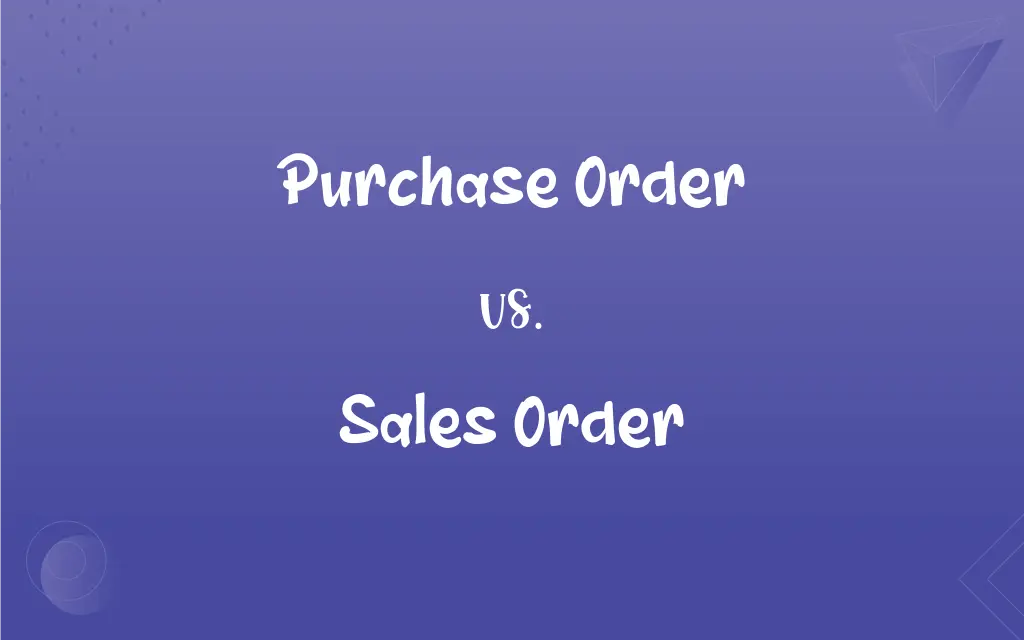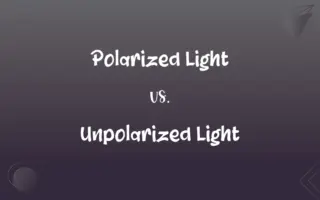Purchase Order vs. Sales Order: What's the Difference?
Edited by Aimie Carlson || By Harlon Moss || Updated on October 11, 2023
Purchase Order (PO) is a buyer’s formal request to a seller, while Sales Order (SO) is a seller's confirmation of a buyer's order. Both serve as legal documentation in buying/selling.

Key Differences
The term "purchase order" refers to a document created by a buyer and sent to a seller, indicating the details of a purchase. This document typically includes the quantity, type, and price of the items being purchased. It functions as a legal offer to buy products or services. On the contrary, the sales order illustrates a seller’s documentation that confirms the sale of goods or services to a buyer. It functions to legally secure the seller’s promise to deliver items or services under specified terms and conditions.
Dive deeper into a purchase order; it serves a critical function in various business aspects, including financial consistency, order accuracy, and legal protection. It enables buyers to clearly communicate their intentions to sellers, ensuring all specifics of a transaction are agreed upon. In contrast, the sales order from the seller’s perspective effectively secures the transaction's specifics from their end. It records the buyer’s order details and confirms the seller's commitment to deliver the ordered items within a certain timeframe.
Precisely, a purchase order comes into play before a transaction is finalized and stands as a legally binding document once accepted by the seller. It plays a vital role in managing and tracking expenses, assisting businesses in maintaining accurate records. Whereas, a sales order becomes crucial post the agreement on transaction terms, ensuring the seller organizes and delivers the products as promised. It is vital for managing revenue and ensuring organized, accurate delivery and invoicing processes.
Purchase orders and sales orders stand vital in inventory management and financial control for businesses. While purchase orders help businesses manage their buying process, avoiding duplicate orders or buying unauthorized goods, sales orders help sellers in managing inventory, production, and delivery processes, ensuring effective operational flow and customer satisfaction.
The lifecycle of both documents within a transaction is sequential where a purchase order’s acceptance by a seller is typically followed by the creation of a sales order. The dual existence and acceptance of these documents ensure both buying and selling entities have consensus and clarity on what is expected in terms of products, pricing, and delivery, thereby safeguarding interests on both sides and ensuring smooth transaction flow and relationship management between buyer and seller.
ADVERTISEMENT
Comparison Chart
Initiator
Buyer
Seller
Purpose
To request/order goods or services
To confirm the sale of goods or services
Timing
Created and sent before a transaction is finalized
Generated after the purchase order is received
Legal Stance
Becomes binding upon seller acceptance
Binding upon creation
Main Function
To specify and control purchasing
To manage, organize, and confirm sale delivery
ADVERTISEMENT
Purchase Order and Sales Order Definitions
Purchase Order
A purchase order is an official document issued by a buyer to a seller indicating types, quantities, and agreed prices for products or services.
The manager issued a purchase order for 100 units of computer hardware to facilitate the office’s technological upgrade.
Sales Order
It represents a binding commitment from the seller to supply certain products or services at stipulated prices to the buyer.
With the issuance of the sales order, the seller guaranteed the delivery of the specified goods within the agreed timeframe.
Purchase Order
It serves as a reference point for reconciliation in financial and inventory management by detailing purchasing information.
Upon receiving the goods, the inventory team cross-referenced them with the initial purchase order to ensure accuracy in delivery and billing.
Sales Order
A sales order is a seller's documented confirmation of receiving a purchase order, detailing the agreed-upon items and services to be sold.
After receiving the purchase order, the supplier promptly created a sales order to confirm the transaction.
Purchase Order
A purchase order provides specific instructions and outlines obligations and expectations towards the seller regarding the delivery of purchased items.
The purchase order explicitly detailed the delivery time frame to prevent any potential delays from the supplier.
Sales Order
Sales orders act as a formal approval from the seller's side, recognizing and agreeing to provide specified goods or services to the buyer.
The sales order outlined the accepted terms and was sent to the buyer for their financial and inventory planning.
Purchase Order
Purchase orders serve as a legal record of items or services requested from a supplier, outlining vital details of a transaction.
To avoid discrepancies, the finance department maintains all purchase orders in a systematic manner.
Sales Order
Sales orders serve to organize and manage the seller’s inventory, production, and delivery processes after accepting a purchase order.
Using the sales order, the production team organized the necessary materials to fulfill the customer's request on time.
Purchase Order
It acts as a control mechanism in businesses to manage and validate the purchasing of goods and services.
Utilizing a purchase order, the company ensured that no unauthorized acquisitions were made during the financial year.
Sales Order
The sales order facilitates accurate invoicing by providing a detailed breakdown of the products, quantities, and agreed prices to be billed to the buyer.
To ensure precise billing, the accounting department generated invoices using the information detailed in the sales order.
FAQs
When is a sales order created?
A sales order is created after a seller receives and agrees to the terms stated in a purchase order.
What is a purchase order (PO)?
A purchase order is a buyer's official request detailing the goods or services to be purchased from a seller.
When is a purchase order used?
A purchase order is used when a buyer wants to request specific goods or services from a seller.
Is a sales order legally binding?
Yes, a sales order is legally binding as it confirms the seller’s commitment to provide the specified goods or services.
What details are included in a purchase order?
Purchase orders usually detail the type, quantity, and price of goods/services, delivery date, and payment terms.
What is a sales order (SO)?
A sales order is a seller's documentation confirming the sale of specified goods or services to a buyer.
Can a sales order be modified?
The ability to modify a sales order often depends on the seller’s policy and the transaction stage.
Who issues a sales order?
The seller issues a sales order to confirm the acceptance and sale of goods or services to a buyer.
Why are purchase orders important?
Purchase orders provide a legal, detailed record of a transaction, helping to manage orders and control expenditures.
What information is in a sales order?
Sales orders typically include transaction details, buyer’s information, detailed order, delivery dates, and pricing.
What happens after a purchase order is accepted?
After a purchase order is accepted, the seller typically issues a sales order and proceeds with order fulfillment.
Can a sales order be automated?
Yes, sales orders can often be automated through various order management or ERP software solutions.
How does a sales order relate to an invoice?
A sales order precedes an invoice, serving as a seller’s commitment, while an invoice requests payment post-delivery.
Is a purchase order legally binding?
Yes, once accepted by the seller, a purchase order becomes a legally binding document.
Can a purchase order be cancelled?
Yes, a purchase order can typically be cancelled before the seller has accepted it or provided the goods/services.
Who issues a purchase order?
The buyer issues a purchase order to request goods or services from a seller.
Why are sales orders important?
Sales orders help sellers manage inventory, production, and delivery while ensuring accurate invoicing.
What follows the issuance of a sales order?
Following a sales order, the seller organizes, produces, and dispatches the goods, then usually issues an invoice.
Can a purchase order be issued electronically?
Yes, purchase orders can be issued electronically, often through e-procurement software or email.
How is a purchase order different from an invoice?
A purchase order is a request for goods/services, while an invoice is a bill issued by the seller after delivery.
About Author
Written by
Harlon MossHarlon is a seasoned quality moderator and accomplished content writer for Difference Wiki. An alumnus of the prestigious University of California, he earned his degree in Computer Science. Leveraging his academic background, Harlon brings a meticulous and informed perspective to his work, ensuring content accuracy and excellence.
Edited by
Aimie CarlsonAimie Carlson, holding a master's degree in English literature, is a fervent English language enthusiast. She lends her writing talents to Difference Wiki, a prominent website that specializes in comparisons, offering readers insightful analyses that both captivate and inform.































































